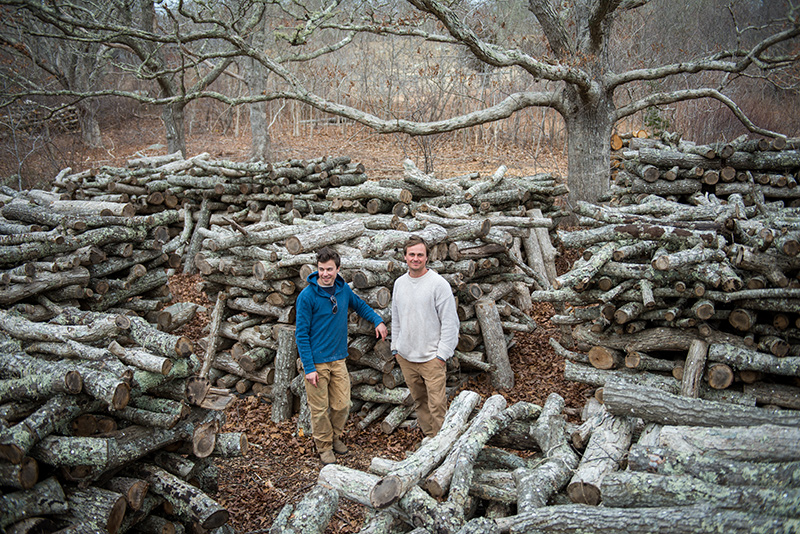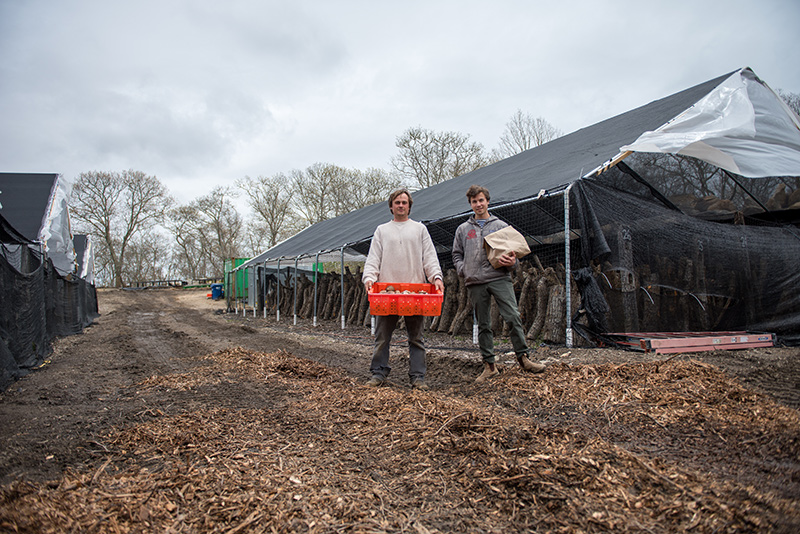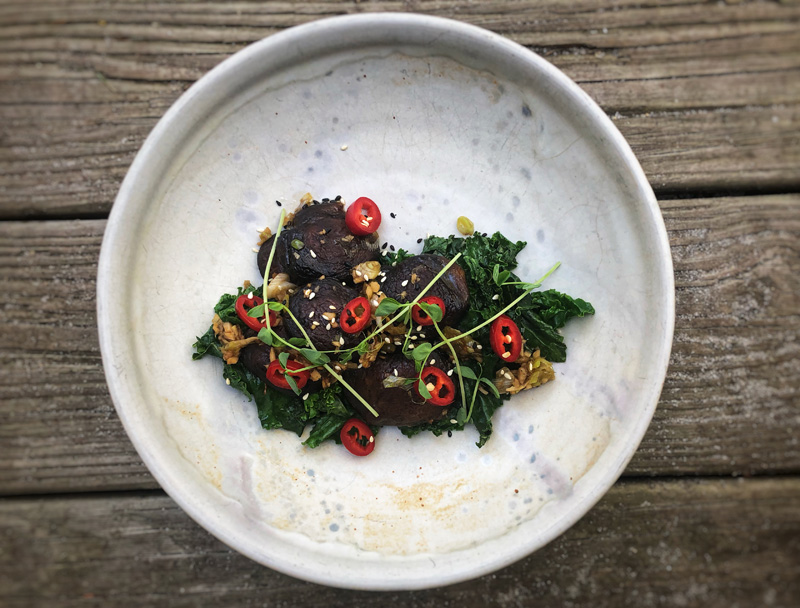A few years ago, while working at 7a Foods in West Tisbury, I was introduced to Martha’s Vineyard Mycological’s (MVM) wild-harvest shiitake mushrooms. We were preparing 10 pounds at a time for a delectable vegetarian sandwich, the Umami Tsunami. In those days, the beloved sandwich shop was one of the top accounts for MVM; today their top account — an off-Island client — receives roughly 300 pounds per week. Lately, as a private chef, I use the wild harvest shiitakes in many forms, from serving them raw to roasting them for a lavender panna cotta.
Tucker Pforzheimer and Truman French founded Martha’s Vineyard Mycological in 2015. They’ve moved around a bit, and are now in Chilmark. The duo met while studying mycology at Harvard University. After school ended they set their sights on farming on the Island, intrigued by the idea of producing a sustainable, environmentally friendly and premium product. As Tucker put it, they wanted to find a “non-processed meat protein alternative that would be suitable for a special occasion, like wagyu beef.” As an avid consumer and preparer of their shiitakes, I can honestly say they nailed it.

Tucker and Truman are impressively knowledgeable, and forward thinking. They made a conscious decision to look at where food would be moving in a decade, and tried to set themselves up as a top producer for the future. With sustainability in mind, and armed with their knowledge of mycology, shiitake mushroom production was a clear choice for them. The Island has an abundance of oak, and the ideal climate — constant humidity and temperatures rarely over 90 degrees. Oak is the traditional medium for growing shiitakes, as the mycelium (root structure) feed on the complex sugars in the vascular cambium (plant tissue) of freshly cut oak logs. Smaller logs with less heartwood (the inner part of a tree) are ideal for shiitake production, and the crew at MVM is adept at finding them without clearing any land themselves. They started small — supplying just a few Island restaurants, and have gradually grown into a boutique producer, selling to top restaurants throughout the Cape, Islands, Boston, and New York City. In four years, they have increased their production by 1,000 percent to meet demand.
The process of using oak logs to cultivate shiitakes is a tradition with roots in Asia, and has been practiced for close to 1,000 years. Each spring, as the weather begins to break, the team at MVM gets to work inoculating oak logs for the future — injecting mycelium into the log, triggering a colonization period that lasts a year and a half. After the colonization period, each log will produce five or six crops per season over a lifespan of about three years. They inoculate logs twice a year on the farm and inoculated roughly 9,000 logs this past fall. I caught up with Tucker and Truman, and their team, as they began inoculating an additional 5,000 logs this spring.
There are currently about 45,000 logs in various stages of production at their farm. MVM is a low-impact farming operation. The logs they inoculated this spring were cleared as part of a preservation effort to restore the scrub oak habitat for the imperial moth. Tucker says that they’ve reached a point where they’re producing as much as is sustainable for the Island’s resources, and are considering expansion off-Island.

They moved to a new location a couple years ago, and the current farm is on a property that was once grazed by sheep, as it was unsuitable for traditional farming. It’s a quiet place at the end of a dirt road. Thousands of neatly stacked oak logs sit on rocky ground. Large shaded greenhouses are home to what seem like endless rows of “pinning,” or fruiting mushrooms. Truman is a wealth of information, and each time I visit the farm I learn more about the landscape of the Island and the ecosystem they have nurtured. He’s schooled me on how the glaciers pushed the rocks that eventually formed the Island into the ocean, and explained the ancient root structures of some of the oak trees you’ll find in the State Forest. I always look forward to visiting this place, not just for the product, but for the people behind it.
Mushrooms reproduce through rhizomatic growth, meaning that their root structure spawns new mushrooms. The vegetative root structure itself is called the mycelium. During inoculation, mycelium is impregnated into several holes in each oak log and capped with a plug. The plug helps prevent pests from feeding on the mycelium before it can grow enough to produce mushrooms.
Once a log has been inoculated, it takes about a year and a half for it to “become fully colonized and ready to fruit,” Truman explains. When the logs have been depleted of their sap, they are completely dry and can be used as firewood, making it one of the lowest impact farming methods around. It’s complicated, but here’s how it works: Oaks grow from their own root structure, meaning that if you top a tree, and leave the stump, the tree doesn’t die. There are old stumps, for instance, in the State Forest, that are many hundreds of years old, and have spawned new trees. So, MVM does not cut down trees — they use what has been cut already. That said, their current production is nearing the maximum of what they can support without needing to plant more trees, so they’re looking for off-Island expansion possibilities.
MVM’s methods of farming are a mix of tradition and innovation, as they reinvent their operation each year. With each reincarnation comes modifying equipment and streamlining procedures to meet an ever-growing demand. Their systems are simple and elegant, and allow for a very small team to produce nearly 1,000 pounds a week at peak production. Everything is done with care and intention, from farming to delivery.
When the logs are fully colonized they are brought to a large water bath, built out of a reclaimed shipping container, to be soaked. “Soaking forces a gas exchange, replacing high concentrations of CO2 that has built from the fungus respirating. Water pushes out the CO2 and allows oxygen-rich air to reenter the log and basically jumpstart the fungus’ metabolism. That stimulates it to fruit,” Tucker said. By contrast, he explained, most indoor commercial shiitake operations force CO2 into the air, then force oxygen rich air into their growing rooms to emulate this process. So, while the guys produce mushrooms the way they do because the natural process appeals to them, their method has the notable upside of being pretty carbon-neutral.

After soaking, the logs are placed inside one of the large greenhouses and stood on end in long rows that seem to go on forever. The mycelium first produce primortia or “pins” that mature rapidly into fully developed shiitakes. Every single mushroom is hand cut from the logs to prevent damage to the mushrooms, as well as to protect the colony in the log for future production. The logs will produce and be harvested within seven to ten days after soaking, then are replaced with a new set of freshly soaked logs to ensure continuous production. Each individual mature log is given about eight weeks rest between inoculations to allow the fungus to “re-metabolise,” Tucker told me. Though they could be soaked more often, the resting period ensures the best quality product.
The crew at MVM takes care to pick the shiitakes when they are at their absolute best. As with a tomato, there is a moment where the mushrooms are just right. Shiitakes with larger caps that have grown beyond the point of perfection are sold as b-grade mushrooms; the “a” grade mushrooms have a firm and beautiful texture. The end result is a visually stunning product with a flavor that is garlicky and sweet. MVM shiitakes are packed with nutrients, including a staggering amount of protein (a half-gram of protein in each mushroom cap, which doesn’t sound like a lot, but it is!), and contain cancer-fighting polysaccharides.
But my favorite thing about their product is that there are no gimmicks. I purchase them in a large paper bag with a simple stamp on it. They are responsibly raised by a team of people whose sincere interest is in the consumer and the land that provides for them.
You can get your very own MVM mushrooms, and talk mycology with the mushroom men themselves at the West Tisbury Farmers Market. The mushrooms are also sold at Morning Glory Farm in Edgartown. To learn more about MVM, visit mvmycological.com.

Sauteed Shiitake with Ginger
1/2 lb MVM Wild Harvest Shiitake Mushrooms (stems removed) 2-3 Tbsp. ginger (minced) 1 bunch scallions (sliced) 2 Tbsp. coconut aminos 1 tsp. rice vinegar 2 Tbsp. water Pinch salt
- Coat a large skillet with olive oil and warm it over medium-high heat
- Add mushrooms in single layer gill side up, and cook for about 1 minute
- Flip mushrooms cap side up, and add ginger, scallion
- Cook for one more minute
- Add coconut aminos and vinegar, and stir all ingredients together
- Once the smell of ginger becomes aromatic, add water and let simmer until the liquid begins to thicken
- Use the scallion ginger pan sauce to dress your dish
- Serve over your favorite greens, rice, noodles, or just eat them on their own!
















